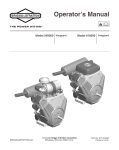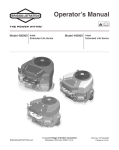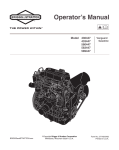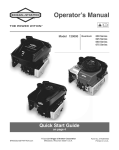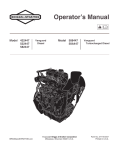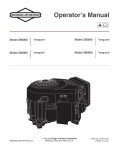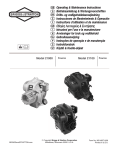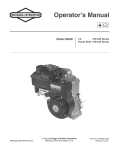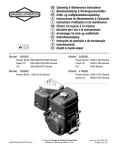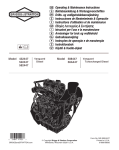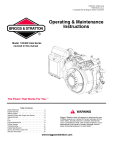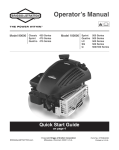Download Craftsman 1450 Series Operator`s manual
Transcript
Operator’s Manual Model 120000 Model 200000 Power Built 825/850/875/900 Series Intek I/C 825/850/875/900 Series I/C 825/850/875 Series Model 150000 Model 210000 Power Built 1100/1125 Series BRIGGSandSTRATTON.com Power Built 1350/1450 Series Intek I/C 1350/1450 Series I/C 1450 Series Power Built 1500/1575 Series Intek I/C 1500/1575 Series ECopyright Briggs & Stratton Corporation Milwaukee, Wisconsin 53201 U.S.A. Form No. 277040-3/07 Printed in U.S.A. Thank You for purchasing this quality-built Briggs & Stratton engine. We’re pleased that you’ve placed your confidence in the Briggs & Stratton brand. When operated and maintained according to the instructions in this manual, your Briggs & Stratton product will provide many years of dependable service. This manual contains safety information to make you aware of the hazards and risks associated with engines and how to avoid them. It also contains instructions for the proper use and care of the engine. Because Briggs & Stratton Corporation does not necessarily know what equipment this engine will power, it is important that you read and understand these instructions and the instructions for the equipment this engine powers. Where to Find Us You never have to look far to find Briggs & Stratton Support and service for your engine. Consult your Yellow Pages™ under “Engines-Gasoline”, “Gasoline-Engines”, “Lawn Mowers” or similar categories. There are over 30,000 Briggs & Stratton authorized service dealers worldwide who provide quality service. You can also contact Briggs & Stratton Customer Service by phone at (800) 233-3723. Additional information can be found on the Internet at www.BRIGGSandSTRATTON.com. For replacement parts or technical assistance, record below the engine model, type, and code numbers along with the date of purchase. These numbers are located on your engine (see the “Features” page). Date of purchase: Engine model: Model: MM/DD/YYYY Type: Code: Briggs & Stratton Corporation P.O. Box 702 Milwaukee, WI, 53201-0702 Copyright E 2006 Briggs & Stratton Corporation, Milwaukee, WI, USA. All rights reserved. Printed in U.S.A. Briggs & Stratton is a trademark of Briggs & Stratton Corporation Milwaukee, WI, USA. Safety . . . . . . . . . . . . . . . . . . . . . . . . . . . . . . . . . . . . . . . . . . . . . . Symbols And Warnings . . . . . . . . . . . . . . . . . . . . . . . . . . . . . . . . . . . . . . . . . . 2 2 5 Operation . . . . . . . . . . . . . . . . . . . . . . . . . . . . . . . . . . . . . . . . . . . 6 10 10 11 11 11 11 12 13 14 14 15 15 Specifications . . . . . . . . . . . . . . . . . . . . . . . . . . . . . . . . . . . . . . 17 Power Ratings . . . . . . . . . . . . . . . . . . . . . . . . . . . . . . . . . . . . . . . . . . . . . . . . . Warranties . . . . . . . . . . . . . . . . . . . . . . . . . . . . . . . . . . . . . . . . . . Engine Warranty . . . . . . . . . . . . . . . . . . . . . . . . . . . . . . . . . . . . . . . . . . . . . . . . Emissions Control System Warranty Statement . . . . . . . . . . . . . . . . . . . . . Specifications 16 Trouble shooting Troubleshooting . . . . . . . . . . . . . . . . . . . . . . . . . . . . . . . . . . . . Maintenance Maintenance Chart . . . . . . . . . . . . . . . . . . . . . . . . . . . . . . . . . . . . . . . . . . . . . Inspect Muffler And Spark Arrester . . . . . . . . . . . . . . . . . . . . . . . . . . . . . . . . Carburetor Adjustment . . . . . . . . . . . . . . . . . . . . . . . . . . . . . . . . . . . . . . . . . . Valve Clearance . . . . . . . . . . . . . . . . . . . . . . . . . . . . . . . . . . . . . . . . . . . . . . . . Spark Plug . . . . . . . . . . . . . . . . . . . . . . . . . . . . . . . . . . . . . . . . . . . . . . . . . . . . . How To Change The Oil . . . . . . . . . . . . . . . . . . . . . . . . . . . . . . . . . . . . . . . . . How To Service The Air Filter . . . . . . . . . . . . . . . . . . . . . . . . . . . . . . . . . . . . . How To Change The Gear Reduction Oil . . . . . . . . . . . . . . . . . . . . . . . . . . . How To Replace The Fuel Filter . . . . . . . . . . . . . . . . . . . . . . . . . . . . . . . . . . . Clean Air Cooling System . . . . . . . . . . . . . . . . . . . . . . . . . . . . . . . . . . . . . . . . Storage (over 30 days) . . . . . . . . . . . . . . . . . . . . . . . . . . . . . . . . . . . . . . . . . . 6 6 7 7 8 9 Operation Maintenance . . . . . . . . . . . . . . . . . . . . . . . . . . . . . . . . . . . . . . . . Features Features . . . . . . . . . . . . . . . . . . . . . . . . . . . . . . . . . . . . . . . . . . . . Oil Recommendation . . . . . . . . . . . . . . . . . . . . . . . . . . . . . . . . . . . . . . . . . . . . Check/Add Oil . . . . . . . . . . . . . . . . . . . . . . . . . . . . . . . . . . . . . . . . . . . . . . . . . . Fuel Recommendations . . . . . . . . . . . . . . . . . . . . . . . . . . . . . . . . . . . . . . . . . Add Fuel . . . . . . . . . . . . . . . . . . . . . . . . . . . . . . . . . . . . . . . . . . . . . . . . . . . . . . How To Start The Engine . . . . . . . . . . . . . . . . . . . . . . . . . . . . . . . . . . . . . . . . How To Stop The Engine . . . . . . . . . . . . . . . . . . . . . . . . . . . . . . . . . . . . . . . . Safety Table of Contents 17 18 18 19 Warranties 1 Safety Safety Symbols And Warnings The safety alert symbol is used to identify safety information about hazards that can result in personal injury. A signal word (DANGER, WARNING, or CAUTION) is used with the alert symbol to indicate the likelihood and the potential severity of injury. In addition, a hazard symbol may be used to represent the type of hazard. SYMBOLS ASSOCIATED WITH THIS PRODUCT Fire Read Manual Explosion Oil Kickback Fuel Hot Surface Fuel Shutoff avoided, might result in minor or moderate injury. Toxic Fumes On Off CAUTION, when used without the alert symbol, indicates a situation that could result in damage to the product. Moving Parts Choke Shock Stop Wear Eye Protection Slow DANGER indicates a hazard which, if not avoided, will result in death or serious injury. WARNING indicates a hazard which, if not avoided, could result in death or serious injury. CAUTION indicates a hazard which, if not WARNING The engine exhaust from this product contains chemicals known to the State of California to cause cancer, birth defects, or other reproductive harm. WARNING Briggs & Stratton does not approve or authorize the use of these engines on 3-wheel All Terrain Vehicles (ATVs), motor bikes, fun/recreational go-karts, aircraft products or vehicles intended for use in competitive events. Use of these engines in such applications could result in property damage, serious injury (including paralysis), or even death. Thrown Objects Fast CAUTION This engine is shipped from Briggs & Stratton without oil. If you start the engine without oil, the engine will be damaged beyond repair and will not be covered under warranty. 2 www.BRIGGSandSTRATTON.com WARNING WARNING When Adding Fuel • Turn engine off and let engine cool at least 2 minutes before removing the gas cap. • Fill fuel tank outdoors or in well-ventilated area. • Do not overfill fuel tank. Fill tank to approximately 1-1/2 inches below top of neck to allow for fuel expansion. • Keep gasoline away from sparks, open flames, pilot lights, heat, and other ignition sources. • Check fuel lines, tank, cap, and fittings frequently for cracks or leaks. Replace if necessary. • If fuel spills, wait until it evaporates before starting engine. • If there is natural or LP gas leakage in area, do not start engine. • Do not use pressurized starting fluids because vapors are flammable. WARNING Engines give off carbon monoxide, an odorless, colorless, poison gas. Breathing carbon monoxide can cause nausea, fainting or death. • Start and run engine outdoors. • Do not start or run engine in enclosed area, even if doors or windows are open. When Starting Engine WARNING • Ensure that spark plug, muffler, fuel cap and air cleaner are in place and secured. • Do not crank engine with spark plug removed. • If engine floods, set choke to OPEN/RUN position, place throttle in FAST and crank until engine starts. When Operating Equipment • Do not tip engine or equipment at angle which causes gasoline to spill. • Do not choke carburetor to stop engine. When Transporting Equipment Rapid retraction of starter cord (kickback) will pull hand and arm toward engine faster than you can let go. Broken bones, fractures, bruises or sprains could result. • When starting engine, pull the starter cord slowly until resistance is felt, then pull rapidly. • Remove all external equipment/engine loads before starting engine. • Direct-coupled equipment components such as, but not limited to, blades, impellers, pulleys, sprockets, etc., must be securely attached. • Transport with fuel tank EMPTY or with fuel shut-off valve OFF. WARNING When Storing Gasoline Or Equipment With Fuel In Tank Rotating parts can contact or entangle hands, feet, hair, clothing, or accessories. Traumatic amputation or severe laceration can result. • Store away from furnaces, stoves, water heaters or other appliances that have pilot light or other ignition source because they can ignite gasoline vapors. • • • • Operate equipment with guards in place. Keep hands and feet away from rotating parts. Tie up long hair and remove jewelry. Do not wear loose-fitting clothing, dangling drawstrings or items that could become caught. 3 Safety Starting engine creates sparking. Sparking can ignite nearby flammable gases. Explosion and fire could result. Gasoline and its vapors are extremely flammable and explosive. Fire or explosion can cause severe burns or death. WARNING Safety Running engines produce heat. Engine parts, especially muffler, become extremely hot. Severe thermal burns can occur on contact. Combustible debris, such as leaves, grass, brush, etc. can catch fire. • Allow muffler, engine cylinder and fins to cool before touching. • Remove accumulated debris from muffler area and cylinder area. • Install and maintain in working order a spark arrester before using equipment on forest-covered, grass-covered, brush-covered unimproved land. The state of California requires this (Section 4442 of the California Public Resources Code). Other states may have similar laws. Federal laws apply on federal land. WARNING Unintentional sparking can result in fire or electric shock. Unintentional start-up can result in entanglement, traumatic amputation, or laceration. Before performing adjustments or repairs: • Disconnect the spark plug wire and keep it away from the spark plug. • Disconnect battery at negative terminal (only engines with electric start.) • Use only correct tools. • Do not tamper with governor spring, links or other parts to increase engine speed. • Do not strike the flywheel with a hammer or hard object because the flywheel may later shatter during operation. When testing for spark: • Use approved spark plug tester. • Do not check for spark with spark plug removed. 4 www.BRIGGSandSTRATTON.com Features A. Spark Plug O B. Air Cleaner (flat or oval) I A C. Choke Control Lever J Features D. Fuel Shut-off Valve E. Rewind Handle F. Finger Guard B G. Throttle Control Lever H. ON/OFF Switch (rewind start models) C I. Fuel Tank and Cap D J. Extended Dipstick (if equipped) K. Short Dipstick (if equipped) E L. Oil Drain Plug Q M. Oil Fill Cap F P N. Engine Identification (located on cover) Model Type Code G O. Muffler Muffler Guard (if equipped) Spark Arrester (if equipped) L H I J A P. Safety Key (electric start models) Q. ON/OFF Switch (electric start models) R. Gear Reduction Unit (if equipped) O O B R N C M L K 5 Operation Oil Capacity CAUTION Model 120000 and 150000 series engines: 20 ounces (0.6 liter). Model 200000 and 210000 series engines: 28 ounces (0.8 liter). If this engine is equipped with a gear reduction unit, the gear reduction case must be filled with oil prior to operating the engine. See “How To Change The Gear Reduction Oil” in the Maintenance Section. Oil Recommendation Operation • Do not use special additives. • Choose a viscosity from the following chart. SAE 30 40° F and higher (5° C and higher) is good for all purpose use above 40°F, use below 40°F will cause hard starting. 10W-30 0 to 100° F (--18 to 38° C) is better for varying temperature conditions. This grade of oil improves cold weather starting, but may increase oil consumption at 80°F (27°C) or higher. Check oil level frequently at higher temperatures. Synthetic 5W-30 --20 to 120° F (--30 to 40° C) provides the best protection at all temperatures as well as improved starting with less oil consumption. 5W-30 40° F and below (5° C and below) is recommended for winter use, and works best in cold conditions. Check/Add Oil Before adding or checking the oil • Place engine level. • Clean the oil fill area of any debris. 2. Insert the dipstick but do not screw in. Oil level should be at FULL mark (C). 3. To add oil, pour oil slowly. Fill to point of overflowing. 4. Replace and tighten the dipstick. Models with oil fill cap (Figure 1) C 1. Remove the oil fill cap (A). B 2. Pour oil slowly. Fill to point of overflowing. 3. Replace and tighten the oil fill cap. B A Figure 1: Oil Fill Cap B C Short Dipstick (Figure 2) 1. Remove the dipstick (B) and wipe with a clean cloth. 6 Figure 2: Short Dipstick www.BRIGGSandSTRATTON.com Extended Dipstick (Figure 3) 1. Remove the dipstick (B) and wipe with a clean cloth. 2. Insert and tighten the dipstick. 3. Remove the dipstick and check the oil level. Make sure the oil is at the FULL mark (C) on the dipstick. 4. To add oil, pour the oil slowly into the engine oil fill (D). DO NOT OVERFILL. After adding oil, wait one minute and then recheck the oil level. 5. Fill to the FULL mark (C) on the dipstick. 6. Replace and tighten the dipstick. B B D C Figure 3: Extended Dipstick This engine is certified to operate on gasoline. The emissions control system for this engine is EM (Engine Modifications). Gasoline must meet these requirements: • Clean, fresh, unleaded gasoline. • A minimum of 87 octane/87 AKI (91 RON). If operating at high altitude, see below. • Gasoline with up to 10% ethanol (gasohol) or up to 15% MTBE (methyl tertiary butyl ether), is acceptable. • Use of any gasoline not consistent with the requirements will void the engine warranty. In some local areas, fuel pumps may be marked if the gasoline contains alcohols or ethers. If you are unsure about the gasoline you purchase, check with your fuel provider. • Do not modify the engine fuel system or carburetor to run on alternative fuels. • Never mix oil with gasoline. All gasoline is not the same. If you experience starting or performance problems after new gasoline has been used in your engine, switch to a different fuel provider or change fuel brands. CAUTION Some fuels, called oxygenated or reformulated fuels, are fuels blended with alcohols or ethers. Excessive amounts of these blends can damage the fuel system or cause performance problems. If any undesirable operating symptoms occur, use gasoline with a lower percentage of alcohol or ether. stabilizer, available as a liquid additive, concentrated liquid cartridge or granular additive. High Altitude use At higher altitudes (over 5,000 feet), 85 octane/85 AKI (89 RON) gasoline can be used. Operation at high altitude may require a high-altitude carburetor jet kit to improve performance and decrease fuel consumption. See an Authorized Briggs & Stratton service dealer for more information. Add Fuel (Figure 4) WARNING Gasoline and its vapors are extremely flammable and explosive. Fire or explosion can cause severe burns or death. • Turn engine off and let engine cool at least 2 minutes before removing the gas cap. • Fill fuel tank outdoors or in well-ventilated area. • Keep gasoline away from sparks, open flames, pilot lights, heat, and other ignition sources. • If fuel spills, wait until it evaporates before starting engine. 1. Stop the engine. Before you remove gas cap (A), let the engine cool at least 2 minutes. 2. Remove the gas cap. Fill the fuel tank (B) to approximately 1-1/2 inches below top of neck to allow for fuel expansion. Be careful, do not overfill. 3. Replace the gas cap before starting the engine. A Fuel Stabilizer To protect the fuel system from gum formation, mix in a fuel preservative when adding fuel. Briggs & Stratton recommends using FRESH STARTt fuel B Figure 4: Gas Cap 7 Operation Fuel Recommendations How To Start The Engine CAUTION This engine was shipped from the factory without oil. If you start the engine without oil, the engine will be damaged beyond repair and will not be covered under warranty. ST O P D Figure 7: Throttle Control Lever CAUTION Operation Some engines may be equipped with OIL GARD®. The OIL GARD® is intended to warn the operator that the engine is low on oil. Always check oil level before starting. Engine damage may occur if the oil level is not properly maintained and will void warranty coverage. If the engine will not start and/or has stopped running, add oil (see “Check/Add Oil” instructions). 5. Rewind Start -- On engines equipped with an ON/OFF switch (B), move the switch to the ON position (Figure 8). On electric start models, push in the safety key (F) (Figure 9). B 1. Check the engine oil. See “Check/Add Oil” in the Operation Section. Figure 8: ON / OFF Switch 2. Turn the fuel shut-off valve (A), if equipped, to the ON position (Figure 5). F A Figure 9: Safety Key 6. Rewind Start -- Firmly hold the starter rope handle (E) (Figure 10). Slowly pull the starter rope handle until resistance is felt, then pull quickly. Figure 5: Fuel Shut-off Valve 3. Move the choke control lever (C) to the CHOKE position (Figure 6). CAUTION To prevent damage to the rewind starting system, do not allow the starter rope to snap back. Let the rope slowly rewind. WARNING C Figure 6: Choke Control Lever 4. Move the throttle control lever (D), if equipped, to position. Operate the engine with the FAST the throttle control lever in the FAST position (Figure 7). 8 Rapid retraction of starter cord (kickback) will pull hand and arm toward engine faster than you can let go. Broken bones, fractures, bruises or sprains could result. • When starting engine, pull the starter rope handle slowly until resistance is felt, then pull rapidly. www.BRIGGSandSTRATTON.com 7. Electric Start -- Push in the safety key (F). Push the ON/OFF switch (B) to the ON position. When the engine starts, release the ON/OFF switch (Figure 11). B F E Figure 11: Electric Start operate with the throttle in FAST Figure 10: Rewind Start position. NOTE: When starting a warm engine after a short shutdown, leave the choke lever in the RUN position. If the engine fails to start, follow the starting instructions beginning with step 3. If assistance is needed, see the “Troubleshooting” Chart. How To Stop The Engine WARNING: Do not move the choke control, if equipped, to CHOKE to stop the engine. Backfire, fire or engine damage could occur. 1. Rewind Start -- On models equipped with a throttle control lever, move the throttle control lever D Figure 12: Throttle Control Lever (D) to SLOW and then to the STOP position (see Figure 12). On models equipped with an ON/OFF switch (B), first move the throttle control lever to the SLOW position and then move the ON/OFF switch to the OFF position (Figure 13). 2. Electric Start -- First move the throttle control lever (D) to the SLOW position and then move the ON/OFF switch (B) to the OFF position (Figure 13). F B Figure 13: Safety Key and ON / OFF Switch 3. Remove the safety key (F). (Figure 13). Store the safety key out of reach of children. A 4. Turn the fuel shut-off valve (A), if equipped, to the OFF position (Figure 14). Figure 14: Fuel Shut-off Valve 9 Operation 8. Slowly move the choke control lever to the RUN position. For maximum performance and engine life, Maintenance Maintenance Chart Procedure 8 Hours or Daily 25 Hours 50 Hours 100 Hours 100-400 Hours Check Oil Level Clean Engine of Debris Service Air Cleaner Pre-Cleaner (if equipped) † Replace Air Cleaner Cartridge (if not equipped with pre-cleaner) † Change Oil n Inspect Muffler And Spark Arrester (if equipped) Replace Air Cleaner Cartridge (if equipped with pre-cleaner) Maintenance Change Oil in Gear Reduction (if equipped) Inspect/Replace Spark Plug Replace Fuel Filter (if equipped) Clean Air Cooling System * Check Valve Clearance * In dusty conditions, clean more often. Check every 25 hours. † In dusty conditions or when airborne debris is present, clean more often. Replace air filter if it is very dirty. n Change oil after first 5 to 8 hours of use, then every 50 hours. Change oil every 25 hours when operating the engine under heavy load or in high temperatures. Regular maintenance will improve the performance and extend the life of the equipment. See any Authorized Briggs & Stratton service dealer for service. Use only original equipment replacement parts. Other parts may not perform as well, may damage the unit, and may result in injury. In addition, use of other parts may void your warranty. • Check the fasteners. Make sure all fasteners are tight. • Follow the information in the Maintenance section to keep the unit in good operating condition. 10 WARNING Unintentional sparking can result in fire or electric shock. Unintentional start-up can result in entanglement, traumatic amputation, or laceration. • Use only correct tools. • Do not tamper with governor spring, links or other parts to increase engine speed. • Do not strike the flywheel with a hammer or hard object because the flywheel may later shatter during operation. www.BRIGGSandSTRATTON.com CAUTION All the components used to build this engine must remain in place for proper operation. Emissions Control Maintenance, replacement, or repair of the emissions control devices and systems may be performed by any non-road engine repair establishment or individual. However, to obtain no charge repairs under the terms and provisions of the Briggs & Stratton warranty statement, any service or emissions control part repair or replacement must be performed by a factory authorized dealer. See the Emissions Warranty. Inspect Muffler And Spark Arrester Spark Plug (Figure 15) Check the spark plug every 100 hours. Replace the spark plug if, upon inspection, the electrode (A) is burned or worn. Make sure that the spark plug is clean. Check the gap with a wire gauge (B). If necessary, reset to .030 in (0.76 mm). Never make adjustments to the carburetor. The carburetor was set at the factory to operate efficiently under most conditions. However, if adjustments are required, see any Authorized Briggs & Stratton service dealer for service. CAUTION The manufacturer of the equipment on which this engine is installed specifies top speed at which the engine will be operated. DO NOT EXCEED this speed. Valve Clearance Check valve clearance every 250 hours. See “Tune-up Specifications” chart. Maintenance Inspect the muffler and the spark arrester (if equipped) every 50 hours. If muffler is equipped with a spark arrester screen, remove the screen for inspection. Replace the screen if damaged or plugged. If inspection determines that replacement parts are required, make sure to use only original equipment replacement parts. Carburetor Adjustment .030 in (.76 mm) NOTE: In some areas, local law requires using a A resistor spark plug to suppress ignition signals. If this engine was originally equipped with a resistor spark plug, use same type for replacement. B Figure 15: Check Spark Plug 11 How To Change The Oil G Remove Oil (Figure 16) 1. With engine off but still warm, disconnect the spark plug wire and keep it away from the spark plug. 2. Remove the oil drain plug (F). Drain the oil into an appropriate receptacle. Note: Some of the various types of oil drain plugs (G) are shown in Figure 16. F Figure 16: Oil Drain Plug 3. Replace and tighten the oil drain plug. Before adding oil A Maintenance • Place engine level. Figure 17: Oil Fill Cap • Clean the oil fill area of any debris. B C Models with oil fill cap (Figure 17) 1. Remove the oil fill cap (A). 2. Pour oil slowly. Fill to point of overflowing. B 3. Replace and tighten the oil fill cap. Short Dipstick (Figure 18) B 1. Remove the dipstick (B) and wipe with a clean cloth. 2. To add oil, pour oil slowly. Fill to point of overflowing. 3. Insert the dipstick but do not screw in. Oil level should be at FULL mark (C). C Figure 18: Short Dipstick B 4. Replace and tighten the dipstick. B Extended Dipstick (Figure 19) 1. Remove the dipstick (B) and wipe with a clean cloth. C D 2. Pour the oil slowly into the engine oil fill (D). DO NOT OVERFILL. After adding oil, wait one minute and then recheck the oil level. 3. Insert and tighten the dipstick. 4. Remove the dipstick and check the oil level. Make sure the oil is at the FULL mark (C) on the dipstick. 5. Replace and tighten the dipstick. 12 Figure 19: Extended Dipstick www.BRIGGSandSTRATTON.com How To Service The Air Filter CAUTION Do not use pressurized air or solvents to clean the filter. Pressurized air can damage the filter and solvents will dissolve the filter. 4. Install the new cartridge and pre-cleaner (if equipped) into the base and onto stud (J). Make sure cartridge fits securely into base (G). 5. Install air filter cover and secure with knob. Make sure the knob is tight. G B WARNING Gasoline and its vapors are extremely flammable and explosive. Fire or explosion can cause severe burns or death. C D F K E Figure 20: Flat Air Filter B The air filter system uses either a flat or oval cartridge. Some models also include an additional pre-cleaner that can be washed and reused. Pre-cleaner (Figure 20, Figure 21, Figure 22) 1. Remove the air filter cover (A). 2. Remove the cartridge (B). 3. Separate the pre-cleaner (C) from the cartridge. 4. Wash the pre-cleaner in liquid detergent and water. 5. Let the pre-cleaner thoroughly air dry. Do not oil the pre-cleaner. 6. Assemble the dry pre-cleaner onto the cartridge. 7. Install the cartridge. 8. Assemble the air filter cover. Flat Air Filter (Figure 20 and Figure 21) 1. Loosen screw(s) (D) that holds the air filter cover (A). 2. Open the cover and remove the cartridge (B). 3. Remove the pre-cleaner (C), if equipped, from the cartridge. Discard the old cartridge. 4. Install the new cartridge. If equipped with a pre-cleaner, install lip (K) on the pre-cleaner at the bottom of the cartridge pleats. 5. On models equipped with air filter shown in Figure 20, insert the cover tabs (E) into the slots (F) located at the bottom of the base (G). 6. Close the cover and tighten the screw(s). Oval Air Filter (Figure 22) 1. Remove the knob (H) and the air filter cover (A). 2. Lift the cartridge (B) off of the base (G). 3. Remove the pre-cleaner (C), if equipped, from the cartridge. Discard the old cartridge. Maintenance • Never start or run the engine with the air cleaner assembly or the filter removed as a fire or explosion could result. A dirty air filter will cause a loss of engine power. If dirt or dust enters the engine through the carburetor, the result will be excessive wear or damage to the engine. Replace a damaged or clogged air cleaner or air filter immediately. A G C A D K D Figure 21: Flat Air Filter H A B J C G Figure 22: Oval Air Filter 13 How To Change The Gear Reduction Oil (Figure 23) Maintenance Change the oil in the gear reduction unit every 100 hours. The gear reduction unit is an optional feature that is not included on all models. If your engine is equipped with a gear reduction unit, service as follows. 1. Remove the oil drain plug (A) and drain the oil into an appropriate receptacle. 2. Install and tighten the oil drain plug. 3. Remove the oil fill plug (B) and the oil level plug (C). 4. To refill, slowly pour SAE 80W90 gear lube into the oil fill hole. Continue to pour until the oil runs out of the oil level hole (C). 5. Install and tighten the oil level plug. 6. Install and tighten the oil fill plug. Important: The oil fill plug has a vent hole (D) that must be installed on the top of the gear case cover as shown. How To Replace The Fuel Filter 1. Before replacing the fuel filter (A), if equipped, drain the fuel tank or close the fuel shut-off valve. Otherwise, fuel can leak out and cause a fire or explosion. 2. Use pliers to squeeze tabs (B) on clamps (C), then slide the clamps away from the fuel filter. Twist and pull the fuel lines (D) off of the fuel filter. 3. Check the fuel lines for cracks or leaks. Replace if necessary. 4. Install new original equipment replacement filter. 5. Secure fuel lines to clamps as shown. D A C D B A C Figure 23: Gear Reduction WARNING Gasoline and its vapors are extremely flammable and explosive. Fire or explosion can cause severe burns or death. • Keep gasoline away from sparks, open flames, pilot lights, heat, and other ignition sources. • Check fuel lines, tank, cap, and fittings frequently for cracks or leaks. Replace if necessary. • Before replacing the fuel filter, drain the fuel tank or close the fuel shut-off valve. • If fuel spills, wait until it evaporates before starting engine. • Always use original equipment replacement parts for fuel system (cap, hoses, tanks, filters, etc.). D B B Figure 24: Fuel Filter 14 www.BRIGGSandSTRATTON.com Clean Air Cooling System (Figure 25) CAUTION Keep linkage, springs and controls (B) clean. Keep the area around and behind the muffler (C) free of any combustible debris. Do not use water to clean the engine. Water could contaminate the fuel system. Use a brush or dry cloth to clean the engine. C WARNING Running engines produce heat. Engine parts, especially muffler, become extremely hot. Severe thermal burns can occur on contact. Combustible debris, such as leaves, grass, brush, etc. can catch fire. This is an air cooled engine. Dirt or debris can restrict air flow and cause the engine to over heat, resulting in poor performance and reduced engine life. Daily or before every use, check the engine for accumulated dirt or debris that may restrict air flow. Use a brush or dry cloth to remove debris from the finger guard (A). Storage (over 30 days) WARNING Gasoline and its vapors are extremely flammable and explosive. Fire or explosion can cause severe burns or death. When Storing Gasoline Or Equipment With Fuel In Tank • Store away from furnaces, stoves, water heaters or other appliances that have pilot lights or other ignition sources because they can ignite gasoline vapors. A B Figure 25: Clean Engine Over time, debris can accumulate in the cylinder cooling fins and cause the engine to overheat. This debris cannot be observed without partial disassembly of the engine. For this reason, have an authorized Briggs & Stratton Service Dealer inspect and clean the air cooling system as recommended in the “Maintenance Chart”. If a FRESH STARTt fuel cap with a cartridge of concentrated slow drip stabilizer is used, there is no need to drain the fuel for seasonal storage as long as the cartridge contains stabilizer. Engine oil While the engine is still warm, change the engine oil. Lubricate cylinder and piston Remove the spark plug and pour approximately 1 oz (30 ml) of engine oil into the spark plug hole. Replace the spark plug and slowly pull the starter rope to distribute the oil. Fuel System Fuel can become stale when stored over 30 days. Stale fuel causes acid and gum deposits to form in the fuel system or on essential carburetor parts. Mix fuel stabilizer with the fuel in the tank or storage container. Run the engine for a short time to circulate stabilizer through the carburetor and engine. Engine and fuel can then be stored up to 24 months. If fuel stabilizer is used, you do not need to drain the gasoline prior to storage. If fuel stabilizer is not used, run the engine until it stops from lack of fuel. Clean engine Clean engine of surface debris, chaff, or grass. Storage Area Store in a clean, dry area. Do not store in the same area as a stove, furnace, water heater, or other appliance that uses a pilot light or has a device that can create a spark. 15 Maintenance • Allow muffler, engine cylinder and fins to cool before touching. • Remove accumulated debris from muffler area and cylinder area. Troubleshooting PROBLEM Engine g will not start Engine g difficult to start or E i runs erratically Engine ti ll or CAUSE Out of fuel Add clean fresh fuel. Carburetor flooded Move the choke control lever to the RUN position. Then follow the starting procedure until the engine starts. Low oil Check oil level. Note: On some engines, if the oil pressure drops below 4-6 psi (0.2-0.4 kg/cm2), an oil pressure switch will either activate a warning light or stop the engine. Fouled spark plug Clean and set spark plug gap. Oil level is above FULL mark on dipstick Drain excess oil from engine to bring oil level to FULL mark on dipstick. Stale fuel Drain fuel tank. Fill with fresh fuel. Dirt in fuel tank Drain and clean fuel tank. Fill with fresh fuel. Carburetor out of adjustment Contact Authorized Briggs & Stratton service dealer. Troubleshooting Engine will not run at full speed Fouled spark plug Engine g smokes excessively y Excessive vibration CORRECTION Clean and set spark plug gap. If the spark plug electrode is burned or worn, replace the spark plug. Dirty air filter Clean or replace air filter. Dirty air filter Clean or replace the air filter. Fouled spark plug Clean and set spark plug gap. If the spark plug electrode is burned or worn, replace the spark plug. Loose parts on engine or equipment Stop engine immediately. Tighten all fasteners. If vibration continues, take the unit to an Authorized Briggs & Stratton service dealer. Need Assistance? Go to www.briggsandstratton.com or call (800) 233-3723 16 www.BRIGGSandSTRATTON.com Specifications Common Service Parts n Engine Specifications Model: Displacement: Bore Stroke 120000 12.48 cu in (206 cc) 2.672 in (68 mm) 2.204 in (56 mm) Model: Displacement: Bore Stroke 150000 15.22 cu in (249 cc) 2.970 in (75.44 mm) 2.200 in (56 mm) Model: Displacement: Bore Stroke 200000 18.64 cu in (305 cc) 3.120 in (79.23 mm) 2.438 in (61.67 mm) Model: Displacement: Bore Stroke 210000 20.85 cu in (342 cc) 3.300 in (83.81 mm) 2.438 in (61.67 mm) Service Part Part Number Flat air filter cartridge 491588 or 5043 Flat pre-cleaner 493537 or 5064 Oval air filter cartridge 697029 Oval pre-cleaner 273356 Oil 100005 Fuel filter 694485 Gas additive 5041 Resistor spark plug 491055 Long life platinum spark plug 5066 Spark plug wrench 89838 or 5023 Spark tester 19368 Oil pump kit 5056 (uses standard electric drill to quickly remove oil from engine) * Engine power will decrease 3-1/2% for each 1,000 feet (300 Tune-up Specifications * Model: Spark Plug Gap: Armature Air Gap: Intake † Exhaust: † 120000 / 150000 .030 in (.76 mm) .010 − .014 in (.25 − .36 mm) .004 − .006 in (.10 − .15 mm) .009 − .011 in (.23 − .28 mm) Model: Spark Plug Gap: Armature Air Gap: Intake † Exhaust: † 200000 / 210000 .030 in (.76 mm) .008 − .012 in (.20 − .30 mm) .004 − .006 in (.10 − .15 mm) .004 − .006 in (.10 − .15 mm) General Information In the state of California, OHV Model 120000 and 150000 engines are certified by the California Air Resources Board to meet emissions standards for 125 hours. OHV Model 200000 and 210000 engines are certified by the California Air Resources Board to meet emissions standards for 250 hours. Such certification does not grant the purchaser, owner or operator of this engine any additional warranties with respect to the performance or operational life of this engine. This engine is warranted solely according to the product and emissions warranties stated elsewhere in this manual. Engine Power Rating Information The gross power rating for individual gas engine models is labeled in accordance with SAE (Society of Automotive Engineers) code J1940 (Small Engine † Valve clearance with valve springs installed and piston 1 / 4 in (6 mm) past top dead center (check when engine is cold). See Repair Manual P/N 272147. nWe recommend that you use an authorized Briggs & Stratton Service Dealer for all maintenance and service of the engine and engine parts. Use only genuine Briggs & Stratton parts. Power & Torque Rating Procedure), and rating performance has been obtained and corrected in accordance with SAE J1995 (Revision 2002-05). Torque values are derived at 3060 RPM; horsepower values are derived at 3600 RPM. Actual gross engine power will be lower and is affected by, among other things, ambient operating conditions and engine-to-engine variability. Given both the wide array of products on which engines are placed and the variety of environmental issues applicable to operating the equipment, the gas engine will not develop the rated gross power when used in a given piece of power equipment (actual “on-site” or net power). This difference is due to a variety of factors including, but not limited to, accessories (air cleaner, exhaust, charging, cooling, carburetor, fuel pump, etc.), application limitations, ambient operating conditions (temperature, humidity, altitude), and engine-to-engine variability. Due to manufacturing and capacity limitations, Briggs & Stratton may substitute an engine of higher rated power for this Series engine. 17 Specifications This is a single cylinder, overhead valve (OHV) air-cooled engine. It is a low emissions engine. meters) above sea level and 1% for each 10° F (5.6° C) above 77° F (25° C). It will operate satisfactorily at an angle up to 15°. Refer to the equipment operator’s manual for safe allowable operating limits on slopes. BRIGGS & STRATTON ENGINE OWNER WARRANTY POLICY Effective 12/06 LIMITED WARRANTY Briggs & Stratton Corporation will repair or replace, free of charge, any part(s) of the engine that is defective in material or workmanship or both. Transportation charges on product submitted for repair or replacement under this warranty must be borne by purchaser. This warranty is effective for and is subject to the time periods and conditions stated below. For warranty service, find the nearest Authorized Service Dealer in our dealer locator map at www.briggsandstratton.com, or by calling (800) 233-3723, or as listed in the ‘Yellow Pages™’. There is no other express warranty, implied warranties, including those of merchantability and fitness for a particular purpose, are limited to one year from purchase, or to the extent permitted by law any and all implied warranties are excluded. Liability for incidental or consequential damages are excluded to the extent exclusion is permitted by law. Some states or countries do not allow limitations on how long an implied warranty lasts, and some states or countries do not allow the exclusion or limitation of incidental or consequential damages, so the above limitation and exclusion may not apply to you. This warranty gives you specific legal rights and you may also have other rights which vary from state to state and country to country. WARRANTY TERMS ** Brand / Product Type Vanguard Extended Life Series, I / C, Intek I / C, Intek Pro Kerosene Fuel Operated Engines All Other Briggs & Stratton Engines Consumer Use 2 years 2 years 1 year 2 years Commercial Use 2 years 1 year 90 days 90 days ** Engines used on Home Standby Generator applications are warranted under consumer use only. This warranty does not apply to engines on equipment used for prime power in place of a utility. Engines used in competitive racing or on commercial or rental tracks are not warranted. The warranty period begins on the date of purchase by the first retail consumer or commercial end user, and continues for the period of time stated in the table above. “Consumer use” means personal residential household use by a retail consumer. “Commercial use” means all other uses, including use for commercial, income producing or rental purposes. Once an engine has experienced commercial use, it shall thereafter be considered as a commercial use engine for purposes of this warranty. No warranty registration is necessary to obtain warranty on Briggs & Stratton Products. Save your proof of purchase receipt. If you do not provide proof of the initial purchase date at the time warranty service is requested, the manufacturing date of the product will be used to determine the warranty period. Warranties ABOUT YOUR WARRANTY Briggs & Stratton welcomes warranty repair and apologizes to you for being inconvenienced. Any Authorized Service Dealer may perform warranty repairs. Most warranty repairs are handled routinely, but sometimes requests for warranty service may not be appropriate. For example, warranty would not apply if engine damage occurred because of misuse, lack of routine maintenance, shipping, handling, warehousing or improper installation. Similarly, warranty is void if the serial number of the engine has been removed or the engine has been altered or modified. If a customer differs with the decision of the Service Dealer, an investigation will be made to determine whether the warranty applies. Ask the Service Dealer to submit all supporting facts to his Distributor or the Factory for review. If the Distributor or the Factory decides that the claim is justified, the customer will be fully reimbursed for those items that are defective. To avoid misunderstanding which might occur between the customer and the Dealer, listed below are some of the causes of engine failure that the warranty does not cover. Normal wear: Engines, like all mechanical devices, need periodic parts service and replacement to perform well. Warranty will not cover repair when normal use has exhausted the life of a part or an engine. Improper maintenance: The life of an engine depends upon the conditions under which it operates, and the care it receives. Some applications, such as tillers, pumps and rotary mowers, are very often used in dusty or dirty conditions, which can cause what appears to be premature wear. Such wear, when caused by dirt, dust, spark plug cleaning grit, or other abrasive material that has entered the engine because of improper maintenance, is not covered by warranty. This warranty covers engine related defective material and / or workmanship only, and not replacement or refund of the equipment to which the engine may be mounted. Nor does the warranty extend to repairs required because of: 1 Problems caused by parts that are not original Briggs & Stratton parts. 2 Equipment controls or installations that prevent starting, cause unsatisfactory engine performance, or shorten engine life. (Contact equipment manufacturer.) 3 Leaking carburetors, clogged fuel pipes, sticking valves, or other damage, caused by using contaminated or stale fuel. (Use clean, fresh, lead-free gasoline and Briggs & Stratton Fuel Stabilizer, Part No. 5041.) 18 4 Parts which are scored or broken because an engine was operated with insufficient or contaminated lubricating oil, or an incorrect grade of lubricating oil (check oil level daily or after every 8 hours of operation. Refill when necessary and change at recommended intervals.) OIL GARD may not shut down running engine. Engine damage may occur if oil level is not properly maintained. Read Operating & Maintenance Instructions. 5 Repair or adjustment of associated parts or assemblies such as clutches, transmissions, remote controls, etc., which are not manufactured by Briggs & Stratton. 6 Damage or wear to parts caused by dirt, which entered the engine because of improper air cleaner maintenance, re-assembly, or use of a non-original air cleaner element or cartridge. (At recommended intervals, clean and re-oil the Oil-Foam element or the foam pre-cleaner, and replace the cartridge.) Read Operating & Maintenance Instructions. 7 Parts damaged by over-speeding, or overheating caused by grass, debris, or dirt, which plugs or clogs the cooling fins, or flywheel area, or damage caused by operating the engine in a confined area without sufficient ventilation. (Clean fins on the cylinder, cylinder head and flywheel at recommended intervals.) Read Operating & Maintenance Instructions. 8 Engine or equipment parts broken by excessive vibration caused by a loose engine mounting, loose cutter blades, unbalanced blades or loose or unbalanced impellers, improper attachment of equipment to engine crankshaft, over-speeding or other abuse in operation. 9 A bent or broken crankshaft, caused by striking a solid object with the cutter blade of a rotary lawn mower, or excessive v-belt tightness. 10 Routine tune-up or adjustment of the engine. 11 Engine or engine component failure, i.e., combustion chamber, valves, valve seats, valve guides, or burned starter motor windings, caused by the use of alternate fuels such as, liquified petroleum, natural gas, altered gasolines, etc. Warranty service is available only through service dealers which have been authorized by Briggs & Stratton Corporation. Your nearest Authorized Service Dealer is listed in the “Yellow Pages™” of your telephone directory under “Engines, Gasoline” or “Gasoline Engines,” “Lawn Mowers,” or similar category. www.BRIGGSandSTRATTON.com Emissions Control System Warranty Statement Briggs & Stratton Corporation (B&S), the California Air Resources Board (CARB) and the United States Environmental Protection Agency (U.S. EPA) Emissions Control System Warranty Statement (Owner’s Defect Warranty Rights and Obligations) California, United States and Canada Emissions Control Defects Warranty Statement below. If any covered part on your engine is defective, the part will be repaired or replaced by B&S. The California Air Resources Board (CARB), U.S. EPA and B&S are pleased to explain the Emissions Control System Warranty on your small off-road engine (SORE). In California, new small off-road engines model year 2006 and later must be designed, built and equipped to meet the State’s stringent anti-smog standards. Elsewhere in the United States, new non-road, spark-ignition engines certified for model year 1997 and later must meet similar standards set forth by the U.S. EPA. B&S must warrant the emissions control system on your engine for the periods of time listed below, provided there has been no abuse, neglect or improper maintenance of your small off-road engine. Owner’s Warranty Responsibilities Your emissions control system includes parts such as the carburetor, air cleaner, ignition system, fuel line, muffler and catalytic converter. Also included may be connectors and other emissions related assemblies. You are responsible for presenting your small off-road engine to an Authorized B&S Service Dealer as soon as a problem exists. The undisputed warranty repairs should be completed in a reasonable amount of time, not to exceed 30 days. Where a warrantable condition exists, B&S will repair your small off-road engine at no cost to you including diagnosis, parts and labor. Briggs & Stratton Emissions Control Defects Warranty Coverage Small off-road engines are warranted relative to emissions control parts defects for a period of two years, subject to provisions set forth As the small off-road engine owner, you are responsible for the performance of the required maintenance listed in your Operating and Maintenance Instructions. B&S recommends that you retain all your receipts covering maintenance on your small off-road engine, but B&S cannot deny warranty solely for the lack of receipts or for your failure to ensure the performance of all scheduled maintenance. As the small off-road engine owner, you should however be aware that B&S may deny you warranty coverage if your small off-road engine or a part has failed due to abuse, neglect, improper maintenance or unapproved modifications. If you have any questions regarding your warranty rights and responsibilities, you should contact a B&S Service Representative at (414) 259-5262. The emissions warranty is a defects warranty. Defects are judged on normal engine performance. The warranty is not related to an in-use emissions test. Briggs & Stratton Emissions Control Defects Warranty Provisions 19 Warranties The following are specific provisions relative to your Emissions Control Defects Warranty Coverage. It is in addition to the B&S engine warranty for non-regulated engines found in the Operating and Maintenance Instructions. 3. No Charge 1. Warranted Parts Repair or replacement of any Warranted Part will be performed at Coverage under this warranty extends only to the parts listed no charge to the owner, including diagnostic labor which leads to below (the emissions control systems parts) to the extent these the determination that a Warranted Part is defective, if the parts were present on the engine purchased. diagnostic work is performed at an Authorized B&S Service a. Fuel Metering System Dealer. For emissions warranty service contact your nearest • Cold start enrichment system (soft choke) Authorized B&S Service Dealer as listed in the “Yellow Pages” • Carburetor and internal parts under “Engines, Gasoline,” “Gasoline Engines,” “Lawn Mowers,” • Fuel pump or similar category. • Fuel line, fuel line fittings, clamps 4. Claims and Coverage Exclusions • Fuel tank, cap and tether Warranty claims shall be filed in accordance with the provisions • Carbon canister of the B&S Engine Warranty Policy. Warranty coverage shall be b. Air Induction System excluded for failures of Warranted Parts which are not original • Air cleaner B&S parts or because of abuse, neglect or improper • Intake manifold maintenance as set forth in the B&S Engine Warranty Policy. • Purge and vent line B&S is not liable to cover failures of Warranted Parts caused by c. Ignition System the use of add-on, non-original, or modified parts. 5. Maintenance • Spark plug(s) Any Warranted Part which is not scheduled for replacement as • Magneto ignition system required maintenance or which is scheduled only for regular d. Catalyst System inspection to the effect of “repair or replace as necessary” shall • Catalytic converter be warranted as to defects for the warranty period. Any • Exhaust manifold Warranted Part which is scheduled for replacement as required • Air injection system or pulse valve maintenance shall be warranted as to defects only for the period e. Miscellaneous Items Used in Above Systems of time up to the first scheduled replacement for that part. Any • Vacuum, temperature, position, time sensitive valves and replacement part that is equivalent in performance and durability switches may be used in the performance of any maintenance or repairs. • Connectors and assemblies The owner is responsible for the performance of all required 2. Length of Coverage maintenance, as defined in the B&S Operating and Maintenance B&S warrants to the initial owner and each subsequent purchaser Instructions. that the Warranted Parts shall be free from defects in materials 6. Consequential Coverage and workmanship which caused the failure of the Warranted Parts Coverage hereunder shall extend to the failure of any engine for a period of two years from the date the engine is delivered to a components caused by the failure of any Warranted Part still retail purchaser. under warranty. Look For Relevant Emissions Durability Period and Air Index Information On Your Engine Emissions Label Engines that are certified to meet the California Air Resources Board (CARB) Tier 2 Emissions Standard must display information regarding the Emissions Durability Period and the Air Index. Briggs & Stratton makes this information available to the consumer on our emissions labels. The engine emissions label will indicate certification information. The Emissions Durability Period describes the number of hours of actual running time for which the engine is certified to be emissions compliant, assuming proper maintenance in accordance with the Operating & Maintenance Instructions. The following categories are used: Moderate: Engine is certified to be emissions compliant for 125 hours of actual engine running time. Intermediate: Engine is certified to be emissions compliant for 250 hours of actual engine running time. Extended: Engine is certified to be emissions compliant for 500 hours of actual engine running time. For example, a typical walk-behind lawn mower is used 20 to 25 hours per year. Therefore, the Emissions Durability Period of an engine with an intermediate rating would equate to 10 to 12 years. Certain Briggs & Stratton engines will be certified to meet the United States Environmental Protection Agency (USEPA) Phase 2 emissions standards. For Phase 2 certified engines, the Emissions Compliance Period referred to on the Emissions Compliance label indicates the number of operating hours for which the engine has been shown to meet Federal emissions requirements. Engines that are certified to meet the California Air Resources Board (CARB) Tier 2 Emissions Standard must display information regarding the Emissions Durability Period and the Air Index. Briggs & Stratton makes this information available to the consumer on our emissions labels. The engine emissions label will indicate certification information. For engines less than 225 cc displacement. Category C = 125 hours Category B = 250 hours Category A = 500 hours Warranties For engines of 225 cc or more displacement. Category C = 250 hours Category B = 500 hours Category A = 1000 hours Briggs & Stratton Engines Are Made Under One Or More Of The Following Patents: Design D-247,177 (Other Patents Pending) 6,691,683 6,647,942 6,622,683 6,615,787 6,617,725 6,603,227 6,595,897 6,595,176 6,584,964 6,557,833 6,542,074 20 6,520,141 6,495,267 6,494,175 6,472,790 6,460,502 6,456,515 6,382,166 6,369,532 6,356,003 6,349,688 6,347,614 6,325,036 6,311,663 6,284,123 6,263,852 6,260,529 6,242,828 6,239,709 6,237,555 6,230,678 6,213,083 6,202,616 6,145,487 6,142,257 6,135,426 6,116,212 6,105,548 6,347,614 6,082,323 6,077,063 6,064,027 6,040,767 6,014,808 6,012,420 5,992,367 5,904,124 5,894,715 5,887,678 5,852,951 5,843,345 5,823,153 5,819,513 5,813,384 5,809,958 5,803,035 5,765,713 5,732,555 5,645,025 5,642,701 5,628,352 5,619,845 5,606,948 5,606,851 5,605,130 5,497,679 5,548,955 5,546,901 5,445,014 5,503,125 5,501,203 5,497,679 5,320,795 5,301,643 5,271,363 5,269,713 5,265,700 5,243,878 5,235,943 5,234,038 5,228,487 5,197,426 5,197,425 5,197,422 5,191,864 5,188,069 5,186,142 5,150,674 5,138,996 5,086,890 5,070,829 5,058,544 5,040,644 5,009,208 4,996,956 4,977,879 4,977,877 4,971,219 4,895,119 4,875,448 4,819,593 4,720,638 4,719,682 4,633,556 4,630,498 4,522,080 4,520,288 4,512,499 4,453,507 4,430,984 D 476,629 D 457,891 D 368,187 D 375,963 D 309,457 D 372,871 D 361,771 D 356,951 D 309,457 D 308,872 D 308,871 www.BRIGGSandSTRATTON.com Models 120000 150000 200000 210000 Engine Specifications Engine Specifications Model: Displacement: Bore Stroke 120000 12.48 cu in (206 cc) 2.672 in (68 mm) 2.204 in (56 mm) Model: Displacement: Bore Stroke 150000 15.22 cu in (249 cc) 2.970 in (75.44 mm) 2.200 in (56 mm) Model: Displacement: Bore Stroke 200000 18.64 cu in (305 cc) 3.120 in (79.23 mm) 2.438 in (61.67 mm) Model: Displacement: Bore Stroke 210000 20.85 cu in (342 cc) 3.300 in (83.81 mm) 2.438 in (61.67 mm) Common Service Parts Service Part Flat air filter cartridge Flat pre-cleaner Oval air filter cartridge Oval pre-cleaner Oil Fuel filter Gas additive Resistor spark plug Long life platinum spark plug Spark plug wrench Spark tester Oil pump kit Part Number 491588 or 5043 493537 or 5064 697029 273356 100005 694485 5041 491055 5066 89838 or 5023 19368 5056 (uses standard electric drill to quickly remove oil from engine) Tune-up Specifications Model: Spark Plug Gap: Armature Air Gap: Intake Exhaust: 120000 / 150000 .030 in (.76 mm) .010 -- .014 in (.25 -- .36 mm) .004 -- .006 in (.10 -- .15 mm) .009 -- .011 in (.23 -- .28 mm) Model: Spark Plug Gap: Armature Air Gap: Intake Exhaust: 200000 / 210000 .030 in (.76 mm) .008 -- .012 in (.20 -- .30 mm) .004 -- .006 in (.10 -- .15 mm) .004 -- .006 in (.10 -- .15 mm) Briggs & Stratton Corporation P.O. Box 702 Milwaukee, WI 53201-0702 www.BRIGGSandSTRATTON.com
























